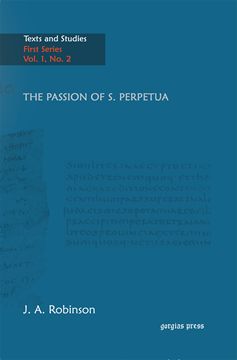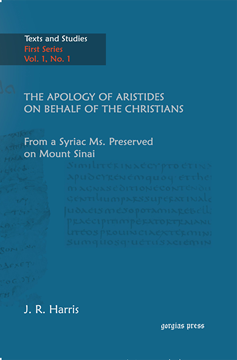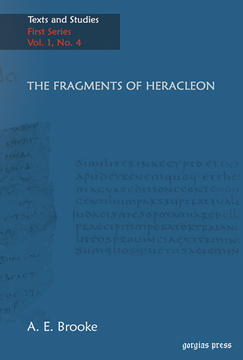The Passion of S. Perpetua
Series: Texts and Studies (First Series) Vol.1, No.2
ISBN: 1-59333-277-7
The story of the two women martyrs S. Perpetua and her slave S. Felicitas (d. 203 CE) have captivated generations of Christians. In this book, the late Cambridge scholar J. A. Robinson provides a study of the Greek and Latin texts of the Passio based on newly discovered manuscripts, as well as the original Latin text of the Scillitan Martyrs, another text of late 2nd century North African martyrdom.
$120.00 (USD)
The Apology of Aristides on behalf of the Christians
Series: Texts and Studies (First Series) Vol.1, No. 1
ISBN: 1-59333-278-5
The Apology of Aristides is the earliest Christian apologia to have survived in its entirety. It was written as a defense of the new Christian way of life against its many rivals and opponents, and details some of its leading ethical precepts. Long thought to have been lost, this early second-century work was rediscovered in a Syriac translation in a seventh-century manuscript preserved in the monastery of St. Catherine on Mount Sinai. This volume contains not only the standard edition of the Syriac text with critical notes, but also the first English translation and a study of surviving fragments in Greek, which were subsequently identified in the 'Life of Barlaam and Josaphat' (an early Christian reworking of the life of Buddha).
$124.00 (USD)
The Fragments of Heracleon
By A. E. Brooke
Series: Texts and Studies (First Series) Vol.1, No.4
ISBN: 1-59333-279-3
Only fragments survive of the writings of the Valentinian Gnostic teacher Heracleon (fl. 145-180 AD). The remnants can be found primarily in quotations in Origen's commentary on the Gospel of John. This study gives an edition of the surviving texts with extensive notes, biblical references, and indices. This volume is indispensable for the study of second century Gnosticism.
$115.00 (USD)
Mosul and Its Minorities
By H. C. Luke
ISBN: 1-59333-107-X
Luke, once Assistant Governor of Jerusalem for the British Mandate government, hopes "to make these singularly interesting peoples better known to English readers, and to win for them additional sympathy in the difficult times through which they are passing."
$135.00 (USD)
The Ancient Church Orders
ISBN: 1-59333-099-5
The Church Orders are an interesting series of manuals in The Ancient Church Orders. A. J. Maclean makes them better known to the modern reader, and explains the extent to which they throw light on early Christian worship and customs.
$134.00 (USD)
Al-Ghazzali's Book of the Ihya
ISBN: 1-59333-111-8
A translation of the Book of Worship by the eleventh-century writer Al-Ghazzali, this is a useful book which explains elements of Muslim worship for those who desire to know more. Annotations help clarify allusions and technical terms referred to in this translation.
$148.00 (USD)





